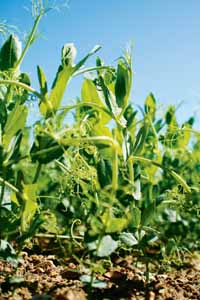Merchants fear shortage of quality marrowfat peas

Pea merchants fear they may run out of quality marrowfat peas this season resulting in the UK losing out in the pulses export market to competing countries.
Concern is growing that demand for peas and beans will outstrip supply for harvest 2011, as growers opt for spring cereals and oilseed rape instead.
Demand for quality UK peas is high, especially for marrowfats in the Far East where there is potential to increase sales, says Phil Rix, president of the British Edible Pulse Association.
“We have a good reputation around the world for growing good-quality, reliable pulses – but if we haven’t got the crop, we can’t supply them.”
High commodity prices since November have nudged wheat and oilseed rape to above £200/t and £400/t respectively, he explains. These strong prices have tempted growers to increase their wheat and oilseed rape acreage, at the expense of break crops like pulses.
“Growers like to know the nuts and bolts of prices and with wheat or rape, they can put it in their fields and sell a proportion of it forward. We don’t have any futures market (in pulses), and when wheat prices are as high as they are, a lot of growers will produce that instead.”
James Wallace, director of Daltons Seeds, predicts the shortfall in pulse-growing potential this year could be as high as 25%. But a shortage could see their value increase in the autumn, he notes, which could be good news for those growing premium-quality marrowfats.
Increasing demand, fuelled by higher soya prices, has already had an effect on prices since the turn of the year, Mr Rix says.
Prices for animal feed and micronising peas and beans are now above £200/t and quality marrowfat peas have contracts in place for harvest at £250-270/t.
There is also likely to be strong demand for blue peas with good samples currently fetching about £250/t – but, like marrowfats, these are in short supply, he adds.
AICC agronomist Marion Self, of Prime Agriculture, says growing pulses can be unpredictable.
“If the weather is good they can do reasonably well, but if it’s really dry in the spring, yields can be poor,” she explains.
Steve Baldock, also an agronomist at Prime Agriculture, says the value of pulses in the crop rotation should not be underestimated as they can reduce insect, weed and disease problems.
“A spring break crop is a must for dealing with the challenge of blackgrass on many farms. Pulses also fix nitrogen in the soil for the following crop, which is another useful benefit.”
PGRO principal technical officer Jim Scrimshaw says it is critical to drill peas and beans into good soil conditions to assist root growth. He warns that drilling pulses too late – in April – could result in a yield penalty, especially if there are drought conditions again this spring.

